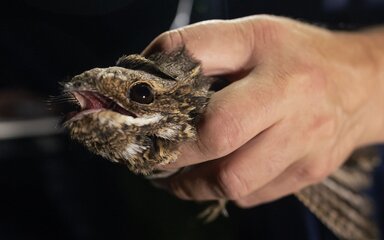What is a nightjar?
The European Nightjar (Caprimulgus europaeus) is a nationally rare bird. They are one of the most important of the many rare species that make their home at Haldon.
Our visiting nightjar spend most of the year in Africa. They migrate to European countries, including the UK, to breed during the summer. That's a round trip of around 7,500 miles!
Read on to find out more about this mysterious and fascinating forest visitor.
Please help us to protect nightjars and all ground nesting birds by keeping yourself and your dogs on main paths.

Special habitats
Nightjars prefer open habitats such as heathland, moorland, and scrubby forest areas, such as young conifer plantation or recently clearfelled sites. Numbers of nightjar in Britain fell dramatically during the 20th century as their heathland breeding habitat was lost. Nowadays, this type of habitat is better understood and valued. Organisations including Forestry England are providing suitable habitat that is helping the nightjar population to slowly recover.
Legal protection
Most of Haldon Forest and Haldon Forest Park is designated a Site of Special Scientific Interest (SSSI). Nightjars and their preferred lowland heath habitat are two of the reasons for this designation. Being a SSSI gives the forest's habitats legal protection and means that we must manage them in certain ways to benefit nature and wildlife.
Nightjar at Haldon Forest
Nightjars are found across many rural sites in Devon and the south west but they are especially important to Haldon, where we have 40-50 pairs each summer. That might not sound very many, but it's around 1% of the entire UK breeding population!
Did you know that the nightjar’s Latin name derives from its mythical ability to steal milk from goats?
Homes for nightjar
As part of our sustainable management of Haldon Forest, we provide a continuous supply of the nightjar’s preferred open habitats. This includes permanent spaces, such as restored heathland, and ‘transitional’ habitat. Transitional habitats are spaces that will change over time, such as when we plant new trees or areas of young trees that will mature.


Activity and feeding
Nightjar are nocturnal. They are most active at dawn and dusk when they hunt for moths and beetles on the wing. Nightjar fly silently and snatch their meals from the air with their wide-opening mouths. When nightjar are not in flight, they can be very difficult to spot because of their outstanding camouflage. Their feathers blend perfectly with the forest floor, making the bird look like a piece of bark.
Behaviour and breeding
Male nightjar have white tips on their wings and clap them together in flight to attract a mate. It is the male which makes the unusual ‘churr’ call that nightjar are famed for.
Female nightjar lay their eggs on the ground where the nesting mother and chicks are perfectly camouflaged. But like other ground nesting birds, this puts nightjar at risk from predators and human disturbance. The chicks hatch within around three weeks and will fledge (leave the nest) by the end of the summer, ready for the autumn migration.
Listen out for the male’s territorial ‘churr’ call and a ‘coo-ick’ contact call which is made by both sexes.
Top tips for nightjar spotting
Have a go at spotting a mysterious nightjar in the forest between May and July with our simple tips:
- At dawn or dusk, find an area of open habitat with a wide view of the sky.
- Stick to a main path and keep still and quiet.
- Listen out for the male's territorial 'churr' and a 'coo-ick' call made by both sexes.
- Nightjar fly silently, but you might see them silhouetted against the darkening sky as they hunt in flight.

